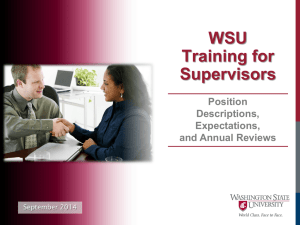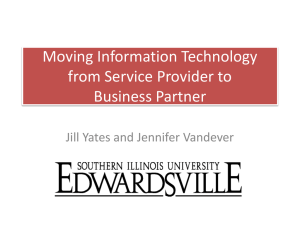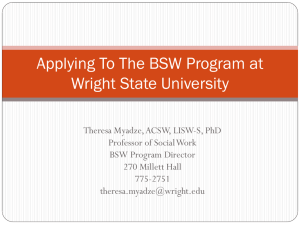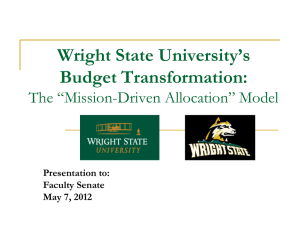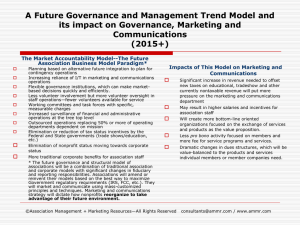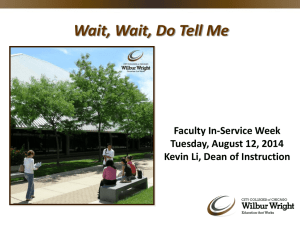360 Information Technology Review pptx
advertisement
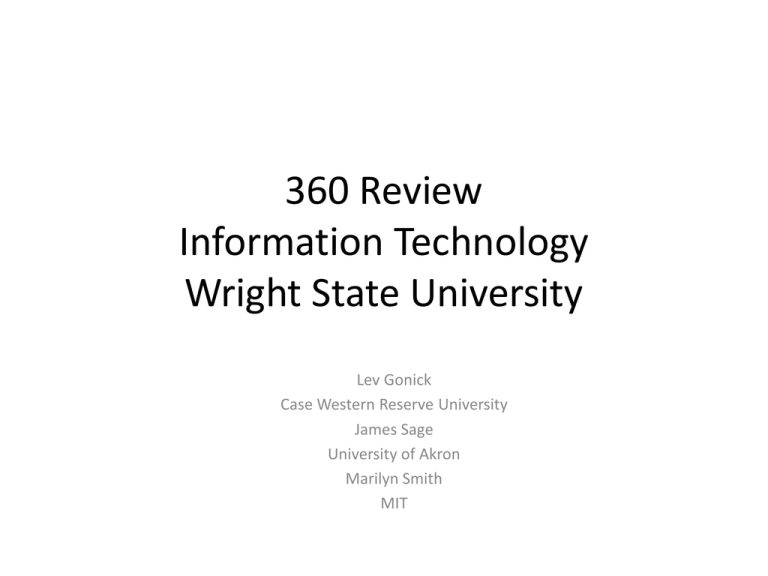
360 Review Information Technology Wright State University Lev Gonick Case Western Reserve University James Sage University of Akron Marilyn Smith MIT Table of Contents 1. 2. 3. 4. 5. 6. 7. 8. 9. 10. 11. 12. 13. 14. 15. 16. 17. 18. 19. 20. 21. External Review Charter Executive Summary Internal Context External Context and Benchmarks Areas of Strength Areas of Weakness Strategic Planning and IT Organizational Values Statement Governance Short Term Opportunities Funding IT Reporting Alignment Enterprise Architecture Solutions Orientation Customer Service Decision Support Scientific and Research Computing Project Management Organizational Structure Summary Recommendations Appendix: List of Interviews 1.0 External Review Charter DATE: TO: FROM: SUBJECT: February 12, 2013 Campus Leaders* Thomas Sudkamp 360° Information Technology Review Next Monday and Tuesday we will be having a 360° review of information technology at Wright State. Three Chief Information Officers will meet with constituent groups across campus to learn of our current and future IT needs. The CIOs will provide a report to the President and Provost on the organizational structure, responsibilities, and mission of a university wide IT infrastructure that is suited for the challenges presented by rapidly changing technology and user needs. The review panel of CIOs will consist of: Lev Gonick, Chief Information Officer, Case Western Reserve University Marilyn Smith, Head of Information Services and Technology (IS&T), MIT Jim Sage, Vice President for Information Technology & Chief Information Officer, University of Akron To ensure that we get input from across campus, each of your units has been given a time to meet with a CIO to discuss your IT needs and concerns. Vice presidents and deans, please feel free to invite participants from your areas who you think should be involved in the campus-wide look to the future. 2.0 Executive Summary 1. 2. 3. 4. 5. 6. 7. 8. 9. 10. 11. 12. 13. 14. The challenges and opportunities facing IT at Wright State University are not unique. Wright State University has a dedicated IT staff. Wright State University is a large, complex, and traditional organization striving to build on its heritage and transform itself to be prepared to be a leader in the State of Ohio for the needs of a 21st century teaching and research organization. IT is understood to be an important enabler of the desired future state. The IT portfolio at WSU is an enterprise-wide provider of critical services and enabling tools for the operation and advancement of every facet of the University’s life. The community expects and increasingly demands that IT at WSU elevate its commitment to outstanding customer service. IT at WSU is not CaTS or CTL or local IT. Need for new organization and re-branding for IT Services. There are a number of short-term actions that can begin almost immediately to re-build confidence in the IT Services offering at WSU. IT at Wright State University needs to be led by a Chief Information Officer. The CIO should report to the Provost. The CIO must be a visionary, an individual with a demonstrable scientific and teaching/learning background and 15 years+ broad and progressively more senior technology management experience. IT at WSU needs a Vision of its future that both aligns to the multi-faceted goals of the University and commits to the stewardship and governance of WSU’s significant investments in people, technology, and solutions to advance all of WSU’s key constituents. The senior executive management at WSU needs to re-affirm its commitment to support the responsibilities and authority of the CIO as a “C” level partner in advancing the broad goals of WSU. The CIO should be encouraged to be an active listener, committed to developing a values-driven organization, proactively building appropriate governance models for inclusion, priority-setting, and executive endorsement, resource allocation, and professional project management of the portfolio of services. 3.0 Internal Context • • Wright State has experienced a lot of change over the past year leading to fatigue and some exasperation. Fragmentation of IT services is an artifact of – – • • • • • • • • • • History and evolution of organizational missions Legacy needs of the University administration While overall financial investment would appear to be appropriate, IT investments are not optimized. Funding of IT opaque to customers. Recurring monthly charges (as a source for funding infrastructure) associated with port and phone charges are in need of re-examination. Strong customer satisfaction articulated among many of the administrative units. Long standing relationships between individuals across the campus supports “you just need to know who to call” culture. Perception, especially among the faculty community, that CaTS is an insular, reactive, and self-serving organization not aligned to the academic mission of the institution. Confusion regarding classroom technology support. Confusion regarding support for learning management system support. Weak tradition of IT planning and governance. Modest investments in collaboration, video, and mobile technologies. Growing sense that IT has been unable to shift its investments and services catalogue from traditional and now commoditized services (“X as a Service”, email, calendaring, collaboration services, AV, lecture capture, data center, etc…), to meet emerging needs to support learning and the needs of the research community. 4.0 External Context and Benchmarks • Wright State University should consider routinizing a 5 year external review of IT services, beginning with a self-study the semester before an external review. • There is a growing collective sense that externalities are generating growing pressure for WSU to ‘get going’ on online education offerings. This effort should be coordinated at the center of the University administration by a senior member of the Provost staff. School-based efforts and disconnected IT efforts should be choreographed by the Provost. A ‘vision’ and a ‘plan’ for WSU online should be the first order of business. • Student retention is a challenge. IT’s role in WSU-wide student retention efforts needs to be coordinated. • Through governance, IT at WSU should benchmark IT to the University’s peers. • Through governance, IT at WSU should educate the campus community of the ‘game changers’ and other externalities driving the need for adaptation and new service models, including IT for the University. 4.1 Example External Context and Benchmarks Source: Educause Annual Core Data Service Indicator Peer Group Title of IT Leader CIO/CTO/VP 97% Reports to President 20%, CAO 20%, CFAO 30%, Combo 30% Reporting in Policy, Infrastructure, Applications, Admin, Help, Academic, Security, Telecom 97% Central IT Headcount Median 140 (range x & y) IT Budget (all in) Median $20m (range x& y) Average percentage of total university expenditures allocated to Central IT 3.87% (range x&y range) Ratio Central-Decentralize IT staff Average 58% (x& y range) WSU 5.0 Areas of Strength • • • • • • • • • • • Broad view that IT staff across the university is dedicated and competent. Help desk is responsive and remote tools are effective. Desktop support is likewise responsive, especially to administration. Desktop replacement program while not as richly funded as desired is appreciated. Expansive adaptive service offering for students with different abilities is a point of pride. Off campus access to scholarly materials is appreciated. Provost is attuned to the challenges facing the campus and is appropriately engaged. Support for administrative and ERP is good and pre-award project is getting good grades. Reporting tools are good. STAC program gets noted as a strength. Annual budget development for IT operating and capital needs meets the needs of the Budget Office. 6.0 Areas For Improvement • • • • • • • • • • • • • • • IT leadership has significant reputational and credibility gaps as reported across the WSU (with noted exceptions). IT leadership is invisible to most faculty, students, and IT staff outside of CaTS. President and the executive are working on a renewal of the University’s strategic plan. IT is invisible. How will IT connect to the priorities of the university. The University is deeply divided into silos. Aligning the university, including IT, to focus on the university’s vision and executing on the vision is vital for the success of WSU. Relatively little evidence of ongoing IT planning, governance, and priority setting. Governance is critical as much for helping the campus answer the question ‘how do IT investments and project get prioritized and funded’ as it is “what will no longer be funded and thus sunset as a service offering.” Organizational values of transparency and customer satisfaction are not evident. Transparency on expenses, priorities, workload are important to building credibility. Operations in central IT would benefit from basic project management, inventory of demands for services/projects, and scorecards of core services. Scorecards, dashboards, and sharing of active monitoring of all services is desired. Collecting and publishing customer satisfaction scores is encouraged. The division of responsibility between CaTS and CTL is not well understood. Frustration with classroom technology (boot up time, login procedures). The University’s web content management project as well as the ongoing production of web content is a source of frustration. There is significant room for improvement in communications with constituents across the University. 7.0 Strategic Planning Imperative Lewis Carroll wrote “If you don’t know where you’re going, any road will get you there.” • Wright State University is engaged in a university strategic planning effort. IT is invisible. Efforts should be made to engage with faculty, staff, students, and administration (including the Board) as to how IT can be both an enabler of the current top priorities as well as a strategic partner to the aspirations of the University. • As Wright State University evolves its IT organization and positioning within the University, IT will have to have a strategic planning exercise to chart its top 3-4 strategic efforts and top 3-4 programmatic initiatives over the next 3 years. These priorities will have to align to the university’s highest priorities. • Through facilitation, the recommended IT strategic planning efforts should afford IT an opportunity to demonstrate its commitment to active listening, to an inclusive and transparent decision-making environment • Among the goals of the IT strategic plan should be an effort to refresh, and renew a governance model for IT decision making at the University (see below). 8.0 Organizational Values Sampling • Through the 360 Review, the following types of values were offered as desirable by those interviewed including faculty, staff, administration, and IT Management. – Transparency – Operational Excellence – Outstanding Customer Experience – Committed to our Students Success – In the Service to the Research Community Group 9.0 Possible IT Governance Structure See http://web.mit.edu/itgc/ https://sites.google.com/a/case.edu/itgovcwru/home/itspacPrimary2013/itspac-charge Role Executive Steering Committee (President, CFAO, CAO, CIO) Set annual goals Authorize major projects and investments Approve policy changes Review outcomes School/College IT Councils, Shape annual goals for technology Deans, Unit Leads Provide feedback on proposed priorities and initiatives Review outcomes Priority Review Committee Approve feasibility and design phase of major projects Recommend major projects and initiatives Recommend priorities IT Governance Subcommittees (Administrative, Academic, Student Impact, Policy, Security, Communications) Identify new needs Participate in solution design Recommend priorities for smaller projects Advise Central IT on the management of domain specific resources IT Governance Body Discuss major trends in technology Provide feedback on initiatives with broad impacts 9.1 Draft Annual Planning Cycle Assess Prior Year Outcomes Scan Environment Set Goals & Constraints Approve Annual Goals and Plans Initiatives Finalize Priorities Preliminary Priorities Schools/College, Deans & Unit Input Solicit Feedback & Refinement 9.2 Annual Planning Cycle For Strategic and Priority Activities (Not Routine Short Work Requests and Daily Operations) Phase Description Who Initiate annual planning Frame planning questions Identify institutional priorities and constraints Executive Steering Committee Goal setting Establish priority goals for technology Schools/College Committee on IT Deans, IT Mgt Surface key strategies and initiatives Identify enterprise and domain specific initiatives to support IT goals IT Governance Subcommittees Preliminary prioritization Preliminary prioritization of recommended initiatives and strategies Priority review committee Discuss and refine priorities Solicit feedback on preliminary prioritization Schools/College Council IT Governance Subcommittees IT Governance Finalize recommendations Finalize proposed initiatives Project review committee Approve annual goals and initiatives, secure Set the IT goals for the year for Central IT and the University Executive Steering Committee 10.0 Short Term Opportunities • • • • • • • Host a monthly open forum on IT issues at the University (based on crowd sourcing of topics). Work to improve single sign on experience. Lean the process of firewall rules and other information security to achieve a better customer experience. Scope a short term project to attend to reported network performance/bandwidth issues. Work with faulty and students to examines WINGS and WINGS Express and implement short term improvements to promote ease of use. Initiate a visible application support and training program. Address issues with classroom technology. – – – – – • Improve communications between CaTS and constituencies it serves. – – – – – • • • Reduce boot-up time Simplify logon procedures Provide faculty training and documentation to address most frequently encountered issues Move Pilot technology support into CaTS to eliminate any finger-pointing between CaTS and CTL when technology issues occur Conduct classroom technology open forums to identify issues and measure ongoing improvements Develop a method for faculty, staff, and students to easily provide input and ask questions of CaTS Put frequently asked questions on CaTS website Create project status web pages on CaTS website Create IT service status page on CaTS website Create "who to call" list on Wings, for IT-related and other issues Website roles and responsibilities, plan and schedule. CaTS budget, expenses and chargeback transparency (as one or more of the monthly open forums). Begin the process of developing academic, administrative, student impact etc… governance groups. 11.0 Funding IT • • • • • • • Wright State does not have a comprehensive inventory and mapping of its IT investments (technology, staff, other). This is an important baseline activity that should be considered. These should include CaTs, CTS, related Library IT investments and decentralized IT investments in other administrative and all academic units. The chargeback model for telecommunication should be re-examined. Investment required for cabling, electronics, wireless access, and faceplate termination for data, voice, and video services should be clearly developed and broadly disseminated. A clear operating and capital investment strategy for IT should be developed through governance. There is broad consensus that Wright State does not optimize its investments in information technology with perhaps 15-20% redundant investments in service lines and personnel. Most of these are legacy investments. After investments in common network infrastructure, IT investments across the campus would appear to be under capitalized in academic and research support. There is broad consensus that the Wright needs significant additional investments in support of academic and research activities associated with the core of the University’s mission. There is general frustration among many of the faculty and some of the Deans that ‘things simply don’t work’. 12.0 Reporting Alignment • High on the priority list for IT Governance should be IT alignment across the University. • A list of principles should be considered to try and align investments and reporting of personnel. – For example, IT staffing at the Colleges/Schools should privilege specific domain expertise in support of specialized research support and needs for specialized teaching and learning environments. Central IT staffing should privilege generalizable, commodity, and utility service lines in support of the enterprise, including research, teaching administration, and reporting. • Focus cross-functional teams to concentrate on most critical strategic issues. – Recruiting, Retention / Student Success, Placement, Serving Adult Students, Online, Research, Economic Development, etc. • “Tip over the silos” 13.0 Enterprise Architecture • As reported, there is no one at Wright State with the responsibility and authority for information technology blueprints 3-5-and 10 years from now. The short-term ‘fix’ orientation of the University is rate limiting as it seeks to position itself as the most innovative university in Ohio. • The role of the architect extends beyond vision and includes a standard, industry-standard methodology for driving adoption to those architectural directions. 14.0 Solutions Orientation • A solutions orientation for central IT is important in demonstrating “value add”. • Central IT services should consider establishing a small and agile services champions (services advocacy) group. This small group should be seen as the leading edge of a commitment to build a division-wide customer- focused solutions organization. The goal for the group is measured by services uptake and engagement. • Customers want, expect, and deserve solutions. • Customers do not care about the functional organization or the organization chart and having a growing frustration between CaTs and CTL. • The focus on projects and solutions will require new skills, attitudes, and commitments in Central IT. 15.0 Customer Service • Customer service is an organizational value and not an operations group within IT. • Senior IT leadership needs to be seen to be driving the organization-wide commitment to outstanding customer experience. • Central IT does have a dedicated team that is viewed as committed to customer success. • Great IT organizations today are committed, measured, and rewarded for customer satisfaction. End of Statement. 16.0 Decision Support • Central IT understands the importance of decision support tools for the University. • There are a number of satisfied customers who regularly use standard and ad hoc queries to support decision making across the University. • There does not appear to be broad adoption of decision support tools for administrative purposes across the university. Growing the number of regular users of these services is important to evolving the broader culture of the university towards a culture of evidence-based decision making. 17.0 Scientific and Research Computing • Big science is certainly on the radar of many of the leading faculty at WSU. Central IT and the Senior Administration of the University should outline the development of a ‘core facility’, including HPC, analytical support and visualization. • Professional and credible management of a scientific and research computing group will be an important factor in the overall effort to relaunch Central IT as having a role in this mission critical and core service. 18.0 Project Management • Like any complex organization, WSU has a need to inventory and manage its hundreds of ongoing and planned projects. • The development of a cross-functional PMI certified project and portfolio management team is highly recommended. • This of course includes IT services. • The current work on the new education building is an example of where cross-functional leadership and project management skills is important. • Another example relates to the less than satisfactory role out of Pilot and Wings. This is not only a matter of communicating forthcoming changes but also driving a formal project and portfolio management methodology. 19.0 Develop Position Descriptions for Key IT Personnel • • • • Chief Information Officer Information Technology Enterprise Architect Senior Scientific and Research Technology Project and Portfolio Management Officer 19.1 CIO Attributes (example) In terms of the performance and personal competencies required for the position, we would highlight the following: Thought Leadership Understands all parts of the University and their interdependencies and uses that knowledge to influence strategy and make decisions that benefit the entire University. Ensures IIT is aligned with the goals and objectives of the University. Considers cross-functional, cross-divisional, and/or University-wide factors when managing the group/function. Identifies emerging information technologies, discerns how they may impact the University, and determines if/when/how to adopt these technologies. Building Relationships and using Influence Builds effective relationships inside and outside of the organization. Effectively relates to others by collaborating and cooperating even with those holding divergent and/or opposing views and goals. Models respect for people from a diverse set of backgrounds and organization levels by seeking and including different thinking styles, cultures, and backgrounds. Setting Strategy Helps develop the University’s information technology vision, translating it into both short- and long-term plans. Creates effective strategies and business plans to focus Wright State on the key University-wide priorities. Considers long-term consequences and implications of actions and decisions for the University. Provides strategic direction by assessing and managing the risks and opportunities associated with industry trends. Executing for Results Sponsors continuous improvement processes, recognizing opportunities to simplify organizational processes and create efficiencies. Anticipates and ensures appropriate resources and structures are in place to support short- and long-term business goals. Creates and/or uses effective metrics to support fact-based decision-making and drive results. Leading Teams Ensures current and future organizational talent needs are met by leading in recruiting, hiring, developing, coaching, and mentoring others. Creates a high-performance and team-oriented culture by planning, instructing, monitoring, guiding, and evaluating others’ job performance and by ensuring that others do so. Motivates teams by actively rewarding and recognizing their efforts. 19.2 Senior Scientific and Research Computing Position (example) • • • • • • • • • • Provide ongoing recommendations on a series of organizational and management options associated with the development of a program of technical support in the use of computing resources and securing computational resources for the conduct of scientific research. Foster and cultivate the optimized use of information technology and, in particular, high performance computing systems in research at Wright State University Provide leadership to scientists, support units, center directors and administrators in expanding the use of high performance computing for research and education. Work with the ORA, Technology Transfer, Research Centers, Support Units, Academic Senate to develop a strategic plan for incorporating advanced computing into the research and educational objectives of the WSU. Work with principal investigators across the University to coordinate the opportunity to leverage investments in computational resources. Develop a close working relationship with computing resource facilities and organizations to make high performance, grid computing, and other appropriate resources available to researchers at the University and keep WSU involved in (inter)national and regional high performance computing and communications initiatives. Work with PIs and researchers across the University in pursuing opportunities for funding to support computationally intensive research projects. Develop a governance model for the Scientific and Research Computing resources at WSU Direct and manage computational resources at the University dedicated to computational research. Teach or facilitate the teaching of classes in the areas of high performance computing and/or research and scientific computing. 19.3 Organizational Structure: Ideal Type Model Provost Chief Information Officer Information Security Officer IT Enterprise Architect Scientific and Research Computing Project and Portfolio Management Design and Plan Build and Source Chief Operating Officer Run and Support Service Champion 19.3 Organizational Structure: Alternative Model Provost Chief Information Officer Information Security Officer IT Enterprise Architect Project and Portfolio Management Infrastructure / Tech Services Development Instructional Services Scientific and Research Computing 20.0 Recommendations 1. Organizational 1.1 Wright State University should actively recruit a CIO with demonstrated strong customer engagement and customer satisfaction commitments along with progressive senior IT management experience (Use a Recruitment Firm). 1.1.1 Before the process of recruiting a CIO commences, the University executive should agree to aggregate the IT-related organizational units (and/or parts of existing organizations) and their respective financial and personnel resources. This will be vital in the CIO recruitment effort. 1.2 The University should actively consider a 50% appointment of an active scientist as Senior Scientific and Computing Officer with a direct reporting line to the CIO, budget, and a senior member of the IT management team. 1.3 In the near term, an Enterprise IT architect should be recruited. 1.4 A successful recruitment and onboarding of a CIO will be greatly enhanced by senior administration decision to consolidate and optimize IT services across the university under the responsibility of the CIO. 2. Planning and Governance 2.1 Wright State University should commit to an IT strategic planning process as a high priority activity. One of the central outcomes should be an IT Governance model. 2.2 Within 12 months there should be a working IT governance model. 2.3 An Executive Steering Committee for IT should be formed this next year. 2.4 Planning and budget cycle alignment should become the target for planning and governance for FY14 (or FY15). 2.5 Central IT should commit to an ongoing benchmarking survey of peers. 2.6 The governance model should include an opportunity for both broad consultation as well as tracks of input and engagement with academic, administrative and other key stakeholders. A Council of IT Leaders should be established to encourage collaboration and sharing of best practices among central IT management and distributed IT. 20.0 Recommendations 3. IT Operations (short term opportunities). 3.1Host a monthly open forum on IT issues at the University (based on crowd sourcing of topics) 3.2 Work to improve single sign on experience 3.3 Lean the process of firewall rules and other information security to achieve a better customer experience 3.4 Scope a short term project to attend to reported network performance/bandwidth issues 3.5 Work with faulty and students to examines WINGS and WINGS Express and implement short term improvements to promote ease of use 3.6 Initiate a visible application support and training program 3.7 Address issues with classroom technology – Reduce boot-up time – Simplify logon procedures – Provide faculty training and documentation to address most frequently encountered issues – Move Pilot technology support into CaTS to eliminate any finger-pointing between CaTS and CTL when technology issues occur – Conduct classroom technology open forums to identify issues and measure ongoing improvements 3.8 Improve communications between CaTS and constituencies it serves – Develop a method for faculty, staff, and students to easily provide input and ask questions of CaTS – Put frequently asked questions on CaTS website – Create project status web pages on CaTS website – Create IT service status page on CaTS website – Create "who to call" list on Wings, for IT-related and other issues 3.9 Website roles and responsibilities, plan and schedule 3.10 CaTS budget, expenses and chargeback transparency (as one or more of the monthly open forums) 3.11 Begin the process of developing academic, administrative, student impact etc… governance groups. 3.12 IT should complete an inventory of existing project proposals, projects underway, completed and integrate them into a project office. 3.13 IT should adopt a project initiation methodology. 3.14 IT should create a dashboard/scorecard for top 10 services and publish. 3.15 IT should consider managing 30-60-90 day plans for each senior manager to focus on deliverables. 4. Customer Service and Communications (short term) 4.1 Short term engagement with marketing and communications consultant to develop a short/mid-range strategy for increasing visibility of IT services 4.2 Help focus on HEAT help ticket management as a customer service (rather than an IT service). 4.3 Measure customer satisfaction. Consider engaging HDI for external validation. 4.4 Work on publishing online self-help services and documentation. 4.5 Develop electronic workflow for job tickets to enable customers to track status. 20.0 Recommendations 5. Collaboration and Events 5.1 IT should actively consider developing 2-3 events in the next year focusing on collaboration opportunities and events (symposia, conferences, celebrations, recognitions) with scientists and decentralized IT across Wright State. 5.2 IT should consider publishing a regular report to the Board (http://www.uakron.edu/dotAsset/ef5495949339-4a0d-919d-e814ea7d8cee.pdf) and make a version of the same available to the broader campus community. An annual report should document and celebrate the ways in which its services help to advance the mission-related services of its customers. 5.3 IT should consider inviting a select number of technology vendors to the University so that the vendors can learn about the strategic activities of WSU. Creating 2-3 strategic partnerships should be the goal 5.4 Consideration should be given to partnering with third parties to source commodity IT services where there is little or no demonstrable value-add to the University by having IT at WSU delivering those services. 6. Other Opportunities (mid-term) 6.1 IT at WSU should play an active role in the University’s on-line strategic plan 6.2 IT at WSU can collaborate with various faculty and Departments to develop a unique offering for online, lifelong, public and continuing professional education. Interview Schedule • To be inserted by Pam

